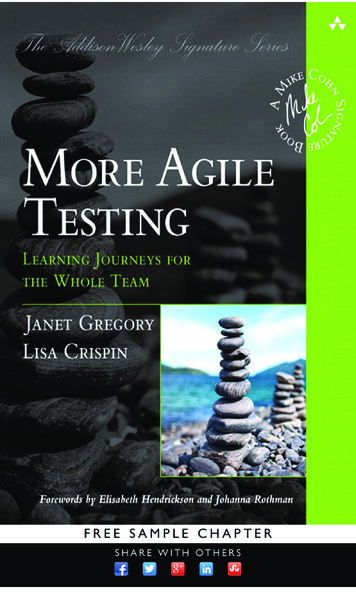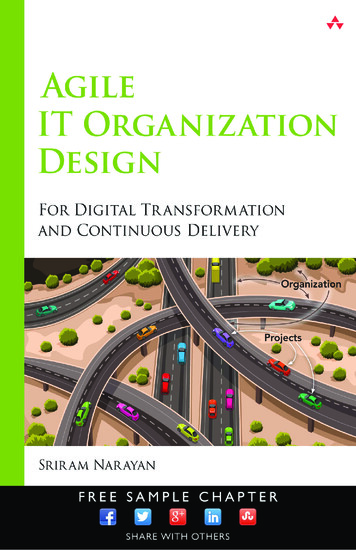
Transcription
Agile Software TestingTen Tips for Launching and Testing High Quality Appsin an Agile EnvironmentWhite PaperJune 2011
White Paper: Agile Software TestingWhite PaperAgile Software TestingTen Tips for Launching and Testing High Quality Apps inan Agile EnvironmentTable of Contents Agile Overview . .- The Agile Manifesto . .- The Problem With Waterfall . - The Emergence of Agile . .- It’s Okay To Use Waterfall . .33344 Ten Tips of Agile Testing .1. Understand the True Role of Testing .2. Unify SRS and Test Plans .3. Define Your Testing Matrix 4. Tell a Story – Not a Use Case .5. Capture Meaningful Data . .6. Fix Broken Windows 7. Make Testing Your Feedback Loop . 8. Timing is Everything .9. Run Frequent Load Tests . .10. Stick to Your Scrums 55567899101011“Simplicity is the ultimatesophistication.”-Leonardo da Vinci About uTest . 122
White Paper: Agile Software TestingIntroductionAgile OverviewA Google search for “agile development” returned 2.7 million results at the time this waswritten. It’s safe to say the word is getting out. But although the basic concepts havebeen actively discussed in books, blogs and everything in between, we’re going to firstreview them anyway. We promise to be quick. If you’ve heard this story before, feel freeto skip ahead to the next section: Tips for Agile Testing.The Agile ManifestoThough ‘Agile’ is a relatively new term, the shift towards more iterative developmentmethodologies began years ago. Eventually, in 2001, a small group of CTOs, academicsand thought leaders published the well-known Agile Manifesto. Here is a summary of thedocument’s fundamental principles:Figure 1: The Agile ManifestoWe are uncovering better ways of developing software by doing it and helping others do it.Through this work we have come to value:Individuals and interactionsWorking softwareCustomer collaborationResponding to changeoveroveroveroverprocesses and toolscomprehensive documentationcontract negotiationfollowing a planThat is, while there is value in the items on the right, we value the items on the leftmore.There have been multiple “spin-offs” of Agile since this document was first published,including Extreme Programming, SCRUM, DSDM, Adaptive Software Development,Crystal, Feature-Driven Development, and Pragmatic Programming, among others.Though they differ in subtle ways, they hold the same foundational values describedabove.The Problem with Waterfall (it’s not agile!)Waterfall development is characterized by well-defined phases, each having a thoroughreview and authorization process that should be completed before proceeding. On thesurface, this process is not inherently bad. In fact, it’s quite logical: First, figure outeverything you need. Then design it. Then code it. Then test it. And repeat.3
White Paper: Agile Software TestingProblems arise when the project requires adjustments and modifications that were notanticipated in the early stages. Reality ruins the plan. So for projects that can be spec’dout with precision ahead of time, waterfall may be the proper choice. Unfortunately,experience has shown that a calm, unchanging set of requirements is a rarity.Whose fault is that? The answer varies depending on who you ask. Upper managementoften blames the product team for not being thorough enough. Product blames sloppycoding by development. Testing blames management for not enforcing tighter deadlinesand cutoffs. “You signed off on the spec two months ago; we can’t add this feature now!”Looking back, it’s no wonder why these projects became the source of such frustration;basically, we delivered software that lacked the most important features! At the sametime, we were up to our necks in fancy-looking documents – MRD, SRS, Architecturediagrams, APIs and Test Plans – that didn’t provide any real value to customers.The Emergence of AgileOut of necessity, development teams began shifting to frequent releases. At first, theseiterative methods went with small cycles, but remained with a fixed schedule ahead oftime (i.e. fixed budget, strict plan, and predetermined feature sets). So instead of the onemajor release, several minor releases would be scheduled.This concept would be taken a step further: Iterative releases, with no fixed plan! Here,each release adds a bit of value, allowing“Agile methods derive much of their for better decisions as to what featuresagility by relying on the tacit would be included next. Development nowknowledge embodied in the team, works in small cycles – planning andrather than writing the knowledge designing only far enough ahead to keepthe flow working. With this increaseddown in plans.”flexibility, the burden of excessive formal- Barry Boehm documentation was greatly alleviated.Software Engineering Guru Now testing is incorporated into each stepof the process, not just at the end of eachrelease.It’s Okay to Use Waterfall – It Isn’t One vs. the OtherAlthough Agile is gaining in popularity, this piece is not an endorsement of one over theother. Many of the tips we’ll discuss in this whitepaper are based on Agile concepts, butare relevant to both types of development processes. So, if your organization usestraditional waterfall methodologies, you can still benefit from Agile concepts to improvequality. This condition has been coined as “Agile-fall.”“There’s no shame in that if that’s what works,” said testing expert John Bach. “Whenyou’re going through a transition from Waterfall to Agile, that may be the best thing asopposed to a sudden lever-pull one day where you show up and your desk is next tosomeone else with no walls and there’s a stack of sticky notes and markers on yourchair with an email to report to your first standup in 30-minutes.”4
White Paper: Agile Software TestingIf your company is developing quality software; if the development is sustainable and thebusiness is being adequately served by that software, there’s really no need to press theissue. Agile is no panacea for problems related to development, process, andmanagement. However, if you’re willing to make some of the necessary changes, it canbe extremely beneficial in the long run.Agile Testing TipsIf you’re operating in an Agile development environment, or just want to adopt more realtime, real-world testing processes, here are some tips that should enable you to improveefficiency and quality:1.Understand the True Role of TestingPeople often think the goal of testing should be to simply findthat’s not entirely realistic. Actually, it’s impossible! Despiteassurance” testers can never truly assure quality, nor can theyevery bug. The real goal of testing should be to improve thewidely held view of testing in the Agile world.all the bugs. Well,the title of “qualitybe expected to findsoftware. This is aDespite this, upper management still tends to believe that testing can uncover all thebugs or prove whether or not the software will function as intended. They wronglyequate testing with validation. To understand the true role of testing, one needs tounderstand that it is a scientific method – a continuous search for information. Soinstead of thinking of tests in terms of ‘pass’ or ‘fail’, try to think of whether or not theyprovide valuable information. In an Agile environment, testers should be called uponto provide this valuable informationthrough the development cycle, as “Testing is the infinite process ofopposed to issuing a ‘pass’ or ‘fail comparing the invisible to thegrade at the end.ambiguous in order to avoid theunthinkable happening to theanonymous.”- James BachTesting ExpertIf Agile is to succeed, testing mustbecome a central pillar of thedevelopment process. It can seemchaotic at first, but when executedproperly, Agile is not chaotic at all.Any methodology that has programmers build unit tests before writing code is orderlyby definition! It’s just a different kind of order – one that focuses on code rather thanpaper, and on value as opposed to blame.2.Unify SRS and Test PlansThis tip requires that you define your testing strategy early on. This does not have tobe a burden. Understand that an SRS (software requirement specification) is quitesimilar to a test plan. From an optimization perspective, it eliminates the wastedprocess sometimes referred to as “Test Plan Alchemy”, in which separate test plans5
White Paper: Agile Software Testingare created by merely copy-pasting from the SRS, and then search-and-replacing“The software should do ” with “Make sure that the software does ”It’s important to note that optimization improves quality. Testers know how to find errors.They also know that errors don’t just appear at the end, they appear throughout theprocess. Finding errors in logic or in usability is a must for Product Managers during thespec phases, yet their skill sets are often geared towards other areas. Looking at theunified SRS/Test Plan with a tester’s eye, therefore, adds tremendous value in the earlystages.3. Carefully Define Your Testing Coverage MatrixThe multi-dimensional matrix of what needs to be tested should be defined early.The importance of this has grown exponentially the past few years, as the matrix hasbecome increasingly complex:Figure 3 – Growth in Complexity of the Compliance MatrixDefining the coverage requirements is an essential part of the specificationsprocess, and thus can be dealt with at an early stage. The size of the coverage6
White Paper: Agile Software Testingmatrix has a significant impact on staffing needs and QA costs. Because of thisfact, defining it clearly and early helps management allocate resources anddetermine what can be done in-house versus what should be outsourced forgreater coverage. This applies to: Operating systemsBrowsersPlug-ins, anti-virus programs and firewallsGeographic locationsLanguagesAnd in the case of mobile applications, handset makers and wirelesscarriersUnless your software is designed for a simple and homogenous audience that’sidentical to your in-house QA team, it’s likely that you have gaps in your testingcoverage. Yet to fill these voids - whether they be browser, OS, location,language or device – would be impractical, expensive and a huge waste of time.With the emergence of crowdsourcing, this is no longer the case. Having alreadyassembled a global testing community, agile teams of all sizes are now able totarget very specific users for specific assignments.4. Tell a Story – Not a Use CaseForget the words “use case” and instead say “storytelling.” In theory, it’s thesame thing, but in reality it’s much different. Toillustrate this difference, try searching for each ofthese terms on Google image. “Use case” bringsimages of dry and intimidating flowcharts anddiagrams, while “story” brings friendly and colorfulpictures.Testers will have a similar subconscious reaction:Ask a tester to build a use case and they will think indry and uninspired terms. But ask them for a story,and you will see the creative juices start to flow. Thisway, you encourage them to be more aggressiveand not settle for simple screen touching.Itempowers the testers, without actually using thecliché word “empowering.”In an Agile environment – where testing is being done continuously – it isespecially important that you keep things fresh. Testing expert James Whittakerhas been an advocate of “test tours.” Here’s an example from his latest book,Exploratory Testing:7
White Paper: Agile Software TestingThe Supermodel Tour:For this tour, I want you to think superficially. Whatever you do, don’t gobeyond skin deep. This tour is not about function or substance; it’s aboutlooks and first impressions. Think of this as the cool tour that all thebeautiful people take; not because the tour is meaningful or a great learningexperience. On the contrary, you take this tour just to be seen.Get the idea? During the Supermodel tour, the focus is not on functionalityor real interaction. It’s only on the interface. Take the tour and watch theinterface elements. Do they look good? Do they render properly, and is theperformance good? As you make changes, does the GUI refresh properly?Although he is essentially discussing test cases, the same idea applies to usecases: encourage creativity whenever possible.5. Capture Meaningful DataTesting managers often focus on information that is of little use to anyone butthemselves - keep this in mind when collecting data. We’re all used to compilingdetailed reports that show the number of test cases written (i.e. how many havebeen run, failure rate, severity levels, etc.) and this is certainly valid data to thetesting manager, but who else in your organization will care? Would thebusiness development team, for instance, have any practical use for this?One type of data that would be of value is direct business impact statistics:Sales missed due to bugs, customer renewal rate and relative cost of defect (seechart below). This type of information is like gold to decision-makers. If you cancollect this data, then do so immediately.Figure 4 – Relative cost of defect, by time of discoveryWhen collecting data, however, be sure not to go overboard. As testing expertMichael Bolton said in a recent interview:8
White Paper: Agile Software Testing“When you enslave numbers, they eventually rise up, revolt, and enslaveyou. These organizations spend so much time collecting the data andtalking about it and justifying it and trying to duck blame that they don’tseem to have time to do anything about the actual problems, whichgenerally fall into two categories. One: the organizations are trying to domore work than they can handle with the approaches they’re using. Two:they’re not listening to people that matter—neither to their customers, norto their own front-line staff, many of whom are closest to the customers.When your car is about to go off a cliff, it’s a weird time to be thinkingabout gas mileage and drag coefficients; better to take the right controlaction—look out the window and steer or use the brake until you’re backon course.”Some statistics, specifically the containment rate, require a certain degree of selfmeasurement. Using a technique such as Evidence-Based Scheduling, therefore,can save you a great deal of time, effort and money. You can find an excellentoverview of this approach here.6. Fix Broken Windows“Fixing broken windows’ is a perfect metaphor for this issue. In the 1980’s, anexperiment was run to measure the impact that broken windows have on crime inurban neighborhoods. Now, we wouldn’t normally think of broken windows as acause of crime. But indeed, it was shown that just fixing broken windows in aneighborhood helped decrease the crime rate. The reason for this is that if you givethe appearance that you don’t care,“Testing is NOT a phase on Agile then others won’t care either.teams, testing is a way of life. Agileteams test continuously. It’s the onlyway to ensure that the featuresimplemented during a given iterationor sprint are actually done.”- Elisabeth HendricksonQuality Tree Software, Inc.It’s the same with your testing efforts.If you continually say “Ignore this bug,it’s a known issue” or “Ignore that test,it’s not yet relevant”, your testing teamwill begin to listen to you: They’ll bemore willing to ignore bugs, and they’llmiss the ones that you don’t wantignored.7. Make Testing Your Feedback LoopThe testing process not only eliminates bugs, it can also serve as source of customerfeedback. If you build a community of testers surrounding your product that trulyrepresent your user base (in terms of demographics, geography, level of knowledge,etc.), you can add feedback into the system before you even launch your products.This is especially important for public web and mobile applications, as opposed toturnkey custom projects.9
White Paper: Agile Software TestingFeedback generated by a community of testers - whether through beta testing orcrowdsourcing - can affirm (or refute) any preconceptions you might have regardingyour software. You will get to see your product used under real-world conditions,something that often does not occur in many QA labs. Better yet, this informationcan be shared with other key decision makers in your organization, notably the salesand marketing departments, who’ll often spend great amounts of money on surveysand research.“My job as a tester includes understanding and advocating for a great customerexperience,” said noted testing blogger Lanette Creamer. “This means feedbackbeyond ‘does this meet requirements’ and evaluating ‘does this meet the customerneeds overall based on all that I know and continue to learn about the customer?’”8. Timing is EverythingThe short release cycles of Agile development can often place QA teams under tighttime constraints. Naturally, there are gaps in your staff’s schedules. The two dayweekend is almost always a period of low development and testing activity, and thisis a good thing – people need their rest to maintain productivity. However, this twoday gap need not go to waste.By adding a crowdsourced community to your testing process, you can deliversoftware releases for testing each Friday and receive the results by Mondaymorning, thus compressing the development cycle without adding pressure to inhouse staff. It’s one thing to be able to get a release out on schedule, but if you andyour staff are working 70 hours a week to get it done, what’s the point? Withcrowdsourcing, there’s finally an easy, cost-efficient way to augment your in-houseQA team.9. Run Frequent Load TestsAs testing becomes integrated with development – and as testing activities becomemore and more compressed – it’s easy to forget about the routine responsibilities.Namely, load testing.At what point will your application’s performance begin to degrade? How manyconcurrent users can it support? How do the JavaScript-based components of yourapplication behave with 50, 100 or 1000 active users? Where are the bottlenecksbetween your code base, database, CDN and load balancers? Without answers tothese questions, your testing data (and efforts) could be all for naught. If yoursoftware can’t hold up under stress, it doesn’t matter how agile your methods are.With recent innovations in crowdsourced testing and open-source tools –innovations that have greatly reduced cost and time commitment – Agile companiesno longer have an excuse for failing to run frequent load tests. Load tests can nowbe run on extremely short notice, while targeting specific functionality as opposed tothe entire application. They can be run with real users or the latest in automatedtechnology. For more on affordable load testing, read Load Testing For Less.10
White Paper: Agile Software Testing10. Stick To Your ScrumsFar from an Agile testing prerequisite, daily Scrum meetings have proven to beextremely beneficial for teams in the long run, as they help departments to remainfocused, energized and coordinated. Writes the Scrum Alliance:In most companies, development is slowed down by issues identified asimpediments during the daily meetings or planning and review meetings. WithScrum, these impediments are prioritized and systematically removed, furtherincreasing productivity and quality. Well-run Scrums achieve the Toyotaeffect: four times industry average productivity and twelve times betterquality.Scrum removes management pressure from teams. Teams are allowed toselect their own work, and then self-organize through close communicationand mutual agreement within the team on how best to accomplish the work.In a successful Scrum, this autonomy can significantly improve the quality oflife for developers and enhance employee retention for managers.Too often, however, daily Scrum meetings become weekly meetings, which in turnbecome monthly meetings. Pretty soon, you no longer recognize Bill fromdevelopment. So set a time that works for everyone, re-introduce yourself to Bill, anddo your best to stick to the schedule. Good luck!For more on testing in an Agile environment, check out this uTest webinar.11
White Paper: Agile Software TestingAbout uTestuTest provides in-the-wild testing services that span the entire software development lifecycle –including functional, security, load, localization and usability testing. The company’s communityof 60,000 professional testers from 190 countries put web, mobile and desktop applicationsthrough their paces by testing on real devices under real-world conditions.Thousands of companies -- from startups to industry-leading brands – rely on uTest as a criticalcomponent of their testing processes for fast, reliable, and cost-effective testing results.More info is available at www.utest.com or blog.utest.com, or you can watch a brief onlinedemo at www.utest.com/demo.uTest, Inc.153 Cordaville RoadSouthborough, MA 01772p: 1.800.445.3914e: info@utest.comw: www.utest.com12
to skip ahead to the next section: Tips for Agile Testing. The Agile Manifesto Though ‘Agile’ is a relatively new term, the shift towards more iterative development methodologies began years ago. Eventually, in 2001, a small group of CTOs, academics and thought leaders published the well-known










